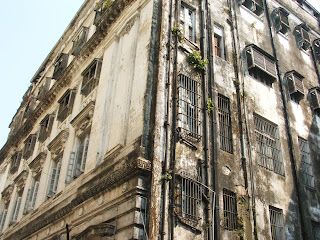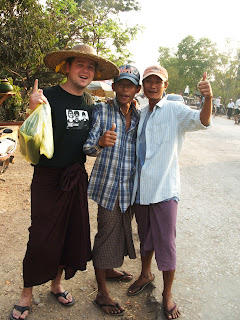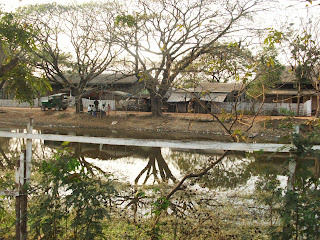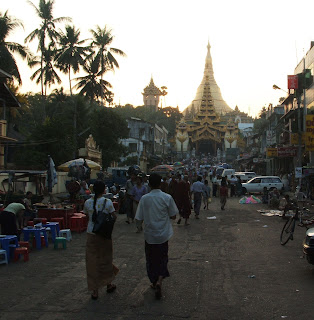I don’t know how the Lonely Planet manage to do it. Actually, I think I have an idea: They plough a lot of resources – these being money and patience - into other resources – these being the human capital of travel journalists – who in turn ply their trade by visiting and living in countries for a number of years and therefore, in the kind of shorthand you would use when interviewing a slick tongued politician, manage to encapsulate a country in a book. I’m not implying that this is at all entirely possible, but in a broad-based manner they do a pretty good job with their travel guidebooks.
I wish those resources were available to me, instead I have in my possession, a lot of torn and tacky hotel brochures and business cards, a weathered, Vietnamese $5 copy of Lonely Planet: Myanmar, a lot of photos, a few souvenirs – some with more meaning than others but all with their own distinct story attached - a couple of Ironcross CDs, an “I-am-a-tourist-for-damn-sure” Mandalay Hill t-shirt, a Moustache Brothers T-shirt and DVD and a scattered head full of memories of dust and temples, blood-red stained teeth and smiling children. So I’ll have to make due with what Sarah and I have but I wouldn’t swop it for anything.
I still don’t know where to kick off this story so lets begin at the start. Yangon. There will be no space in this post for Bagan or Mandalay which will have to wait until tomorrow or Tuesday.
Yangon, or Rangoon, as it was known in the Burmese days (the actually colonial time in history, not George Orwell’s 1934 novel) is way past post-colonial, and a long way short of developed infrastructure. Mildewed, gothic architecture holds hands with shantied establishments, all sporting the upside-down, iron umbrella haircut which comes with thousands of satellite dishes beaming in BBC and HBO even though the government urges the people, by means of large billboards and newspaper entries to “oppose those relying on external elements, acting as stooges, holding negative views” and “crush all internal and external destructive elements as the common enemy” (propoganda of which we made signs only to be nearly dispossessed of them, but that's for another day). These colonial façades bake gloriously in the wide-laned main roads and the ramshackled, burned shell of empty buildings throw cool shadows across the beehived alleyways where longyi-wearing men and women squat in the shade, sipping on tea, chew on betel nuts or smoke cheroots.
The motorbikeless roads (another government decree) are badly tarred hobbled affairs – except the one to the international airport which is immaculate –lined by large tropical trees and canalled sidewalks bustling with the trade and furor of the everyday: street markets, food stalls, hawkers, the inevitable tea-shops and betel-nut stalls, all vying for your attention as you traverse the various obstacles that follow in the wake of a people forgotten and oppressed and a city lost despairingly in disrepair: shopkeepers digging the grey, sludgy gunk out of the blocked canals crossing their shopfronts, uneven blocks of cracked concrete haphazardly laid down as if by an ancient, drunk stonemason, decaying litter and stray dogs lazing in the sun.
Yangon has a certain, distinct smell – not unlike Saigon. It is one of those smells you don’t recognise until you leave and return, which is when your olfactory senses light the spark in your neurons. By no means pleasant, it is still reassuring, like home baking or, the comforting sights and sounds of everyday activities that you are used to. It would be audacious and highly ignorant of me to say it’s the smell of hope, but it is intertwined with life of the common Yangon residents. Figuratively, there’s the sharp, sour smell of fear brought about by years of oppression; it mingles with short gasps and jerky, nervous body language and flickering eyes as a troupe of confident police officers straddle through the market. There’s the religious smell of austerity and age-old tradition in the form of musky, incense drifting from shrines and payas (pagodas) blown across the city to settle with the haze of dust and pollution like a smoky, tortoiseshell blanket across Yangon. There’s the smell of business, the musty smell of new and old money exchanging hands for similarly new and used clothes and bolts of cloth accompanied by the constant chatter of merchants and children laughing and crying. Everything in Yangon belies the history of the country and none more so then the people and food. Amidst the noonday bustle Indian faces melt in with lighter, smoother Chinese looks and rounder Burmese faces, and street-stalls selling hin (Burmese curry), noodles, chapattis and Indian curries, whilst a musallee call Muslims to prayer and Buddhist monks in maroon robes trail piously through the streets, creating a smorgasbord of sensory overload.
Yet, despite the melting pot of sights and sounds, the underlying religious principles of Buddhism rule not only the spiritual but also the common, working day lives of the people of Myanmar and Yangon. Perhaps it is partly due to the ever-present payas, with their intricately designed statues, steps and shrines that stand as sentinels and watch solemnly as the golden hue of their roof reflects brilliantly in the midday sun for all to see and is lit up magnificently at night. None more so then the massive and noble, jewel and gold encrusted Shwe Dagon Paya that stands as out of place as a magnificently polished, antique centrepiece would stand on an unvarnished, weathered table that has only three legs. Perhaps the ever presence of the omnipotent is what causes the Burmese to practise their religion so devoutly and live life with such simple austerity and sincerity, perhaps it is tradition suffused in this sea of mental well-being and future freedom from suffering, that is one of the primary practises of Therevada Buddhism, that causes the Burmese to have what seems to be such ease and acceptance with their situation.
Ironically, it is perhaps partly these principles of Therevada which allow the government to maintain such power and domination over the country – besides the everpresent fear of being thrown in prison for a unforeseeable amount of time or, worse, lugged off to a forced labour camp in the northern rural provinces of a country for no reason other than having the entrepreneurial spirit to show a tourist around town, that is. This actually happened to the brother of Kin Se Be, a young girl we met. At age 14 he was taken to prison and three years later he is still in prison while she now took up the reigns where he left off to make some extra money after to school to buy food and necessities to take to her brother.
I wish those resources were available to me, instead I have in my possession, a lot of torn and tacky hotel brochures and business cards, a weathered, Vietnamese $5 copy of Lonely Planet: Myanmar, a lot of photos, a few souvenirs – some with more meaning than others but all with their own distinct story attached - a couple of Ironcross CDs, an “I-am-a-tourist-for-damn-sure” Mandalay Hill t-shirt, a Moustache Brothers T-shirt and DVD and a scattered head full of memories of dust and temples, blood-red stained teeth and smiling children. So I’ll have to make due with what Sarah and I have but I wouldn’t swop it for anything.
I still don’t know where to kick off this story so lets begin at the start. Yangon. There will be no space in this post for Bagan or Mandalay which will have to wait until tomorrow or Tuesday.
Yangon, or Rangoon, as it was known in the Burmese days (the actually colonial time in history, not George Orwell’s 1934 novel) is way past post-colonial, and a long way short of developed infrastructure. Mildewed, gothic architecture holds hands with shantied establishments, all sporting the upside-down, iron umbrella haircut which comes with thousands of satellite dishes beaming in BBC and HBO even though the government urges the people, by means of large billboards and newspaper entries to “oppose those relying on external elements, acting as stooges, holding negative views” and “crush all internal and external destructive elements as the common enemy” (propoganda of which we made signs only to be nearly dispossessed of them, but that's for another day). These colonial façades bake gloriously in the wide-laned main roads and the ramshackled, burned shell of empty buildings throw cool shadows across the beehived alleyways where longyi-wearing men and women squat in the shade, sipping on tea, chew on betel nuts or smoke cheroots.
The motorbikeless roads (another government decree) are badly tarred hobbled affairs – except the one to the international airport which is immaculate –lined by large tropical trees and canalled sidewalks bustling with the trade and furor of the everyday: street markets, food stalls, hawkers, the inevitable tea-shops and betel-nut stalls, all vying for your attention as you traverse the various obstacles that follow in the wake of a people forgotten and oppressed and a city lost despairingly in disrepair: shopkeepers digging the grey, sludgy gunk out of the blocked canals crossing their shopfronts, uneven blocks of cracked concrete haphazardly laid down as if by an ancient, drunk stonemason, decaying litter and stray dogs lazing in the sun.
Yangon has a certain, distinct smell – not unlike Saigon. It is one of those smells you don’t recognise until you leave and return, which is when your olfactory senses light the spark in your neurons. By no means pleasant, it is still reassuring, like home baking or, the comforting sights and sounds of everyday activities that you are used to. It would be audacious and highly ignorant of me to say it’s the smell of hope, but it is intertwined with life of the common Yangon residents. Figuratively, there’s the sharp, sour smell of fear brought about by years of oppression; it mingles with short gasps and jerky, nervous body language and flickering eyes as a troupe of confident police officers straddle through the market. There’s the religious smell of austerity and age-old tradition in the form of musky, incense drifting from shrines and payas (pagodas) blown across the city to settle with the haze of dust and pollution like a smoky, tortoiseshell blanket across Yangon. There’s the smell of business, the musty smell of new and old money exchanging hands for similarly new and used clothes and bolts of cloth accompanied by the constant chatter of merchants and children laughing and crying. Everything in Yangon belies the history of the country and none more so then the people and food. Amidst the noonday bustle Indian faces melt in with lighter, smoother Chinese looks and rounder Burmese faces, and street-stalls selling hin (Burmese curry), noodles, chapattis and Indian curries, whilst a musallee call Muslims to prayer and Buddhist monks in maroon robes trail piously through the streets, creating a smorgasbord of sensory overload.
Yet, despite the melting pot of sights and sounds, the underlying religious principles of Buddhism rule not only the spiritual but also the common, working day lives of the people of Myanmar and Yangon. Perhaps it is partly due to the ever-present payas, with their intricately designed statues, steps and shrines that stand as sentinels and watch solemnly as the golden hue of their roof reflects brilliantly in the midday sun for all to see and is lit up magnificently at night. None more so then the massive and noble, jewel and gold encrusted Shwe Dagon Paya that stands as out of place as a magnificently polished, antique centrepiece would stand on an unvarnished, weathered table that has only three legs. Perhaps the ever presence of the omnipotent is what causes the Burmese to practise their religion so devoutly and live life with such simple austerity and sincerity, perhaps it is tradition suffused in this sea of mental well-being and future freedom from suffering, that is one of the primary practises of Therevada Buddhism, that causes the Burmese to have what seems to be such ease and acceptance with their situation.
Ironically, it is perhaps partly these principles of Therevada which allow the government to maintain such power and domination over the country – besides the everpresent fear of being thrown in prison for a unforeseeable amount of time or, worse, lugged off to a forced labour camp in the northern rural provinces of a country for no reason other than having the entrepreneurial spirit to show a tourist around town, that is. This actually happened to the brother of Kin Se Be, a young girl we met. At age 14 he was taken to prison and three years later he is still in prison while she now took up the reigns where he left off to make some extra money after to school to buy food and necessities to take to her brother.
I’ll harp on about this point often but this country truly is one of contradictions. It is baffling to think how such beauty and serenity which can be found everywhere in a city and people that is so stifled by the white-knuckled grip of a government that knows no other way than to force their autocratic, tyrannical priniciples upon those beneath them to the point of strangling. The contradiction of a broad-faced face split in half with a smile, showing a mouthful of betel-nut-stained teeth and a cheerful “Mingalaba!” (Hello!), only to recognise the trepidation and well-hidden panic in the eyes behind. This is truly a country where serenity and beauty can sit hand in hand at the same table as fear and hopelessness.










6 comments:
Welkom terug! Bly jy is veilig! Cool pics...nog nie die hele post gelees nie - te veel krioelende wit lettertjies. Sal beslis later - wanneer ek baie werk het - 'n punt daarvan maak om dit deur te werk.
Intussen, lekker werk. Ek hoor jy't vir Xtoff so lekker welcome home party gegooi. Skande dat hy nie eens vir julle presente gebring het nie. Jy glo tog nie regtig die storie dat hy dit op die vliegtuig vergeet het nie? Klink of hy 'n eventful trip gehad het.
Anyway...dit is 'n baie snaakse tannie wat op daai een foto is. Vat jy gat?
Sjoe, hoeveel keer kan mens "werk" in twee sinne indruk?
Xtoff is te min. Punt. Dink ek moet 'n post oor my housemate doen. Moenie te hard werk nie. As ek kans kry sal ek nog kriolende wit lettertjies oor Mandalay net vir jou tik!
Hizit Dude
Seems like you had another one of those "cultural awareness" moments. Nearly like the one Boy, Trev and I had spending 3 days in Kleinbaai during December.
Well written post, makes me want to go over there right this moment. When is the next flight?
Oh and Happy Birthday if you never got my SMS. Cheers Geez
Hey guv, I guess you could compare it to your Kleinbaai experience, minus the brandy.
Happy B-day to you too. Didn't get or send any msgs, The Myanmar government don't allow that kind of thing.
Chiars!
Post a Comment